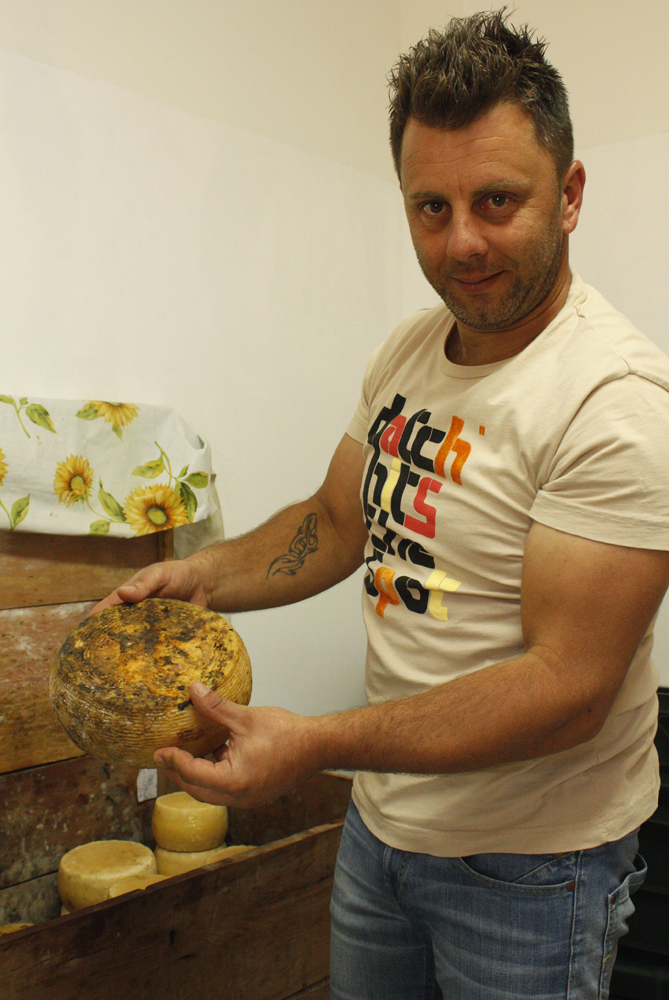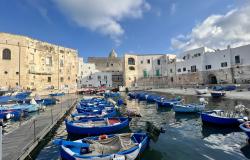“I just know when it is ready”, says Lucia D’Angelo lightly touching with the back of her hand the curdling ewe’s milk that is heating up slowly in a large cauldron. There is no school or course that teaches how to make pecorino di Farindola, the prized sheep cheese from a small mountainous area, in the heart of the National Park of Gran Sasso and Monti della Laga in Abruzzo. The cheese is made exclusively by women and local girls learn the skills from their mothers as they grow up. “Only a woman has the patience to make good pecorino in a slow unrushed manner”, tells me Lucia. It has always been that way: the men tend the livestock, do heavy work outdoors and the women, with their gentle hands, work the milk. Gas burners and electric stoves have replaced the fire but the process of cheese making has remained unchanged here since Roman times when Vestini, a local tribe, lived in this mountains. It is the only cheese in the world that is still, like in old days, made with pig rennet. According to Pliny the Elder, Roman emperors and nobles loved the sheep cheese from the land of Vestini.
 Making pecorino with Lucia, Ph: Anna Lebedeva
Making pecorino with Lucia, Ph: Anna Lebedeva
Just like with many other traditional Italian products, pecorino production has seen ups and downs, although, local farmers never really stopped making it for family consumption and that what saved it. Interest in pecorino di Farindola was renewed in the 1990s as traditional small-scale farm production went through a revival.
Lush green pastures and fresh mountain air give the pecorino complex fragrant flavours, when combined with the characteristic sweet note from the pig rennet it makes this cheese stand out. A big hype was created at the international cheese fair organised by Slow Food in 2001. 100 kg of Pecorino di Farindola were sold within a couple of hours and everyone wanted to know more about the rare cheese from Abruzzo. On the wave of interest the Pecorino di Farindola Consortium was established to safeguard this unique cheese and revitalise its production. Today 20 small family-run farms make 90,000 kilos of pecorino every year, however, it is not enough to satisfy the ever-growing demand from Italian and international buyers.
 Pecorino: Ph: Anna Lebedeva
Pecorino: Ph: Anna Lebedeva
The oldest member of the Consortium is an 86 year-old woman, however, in recent years, a few younger people joined. “We still have a long way to go”, tells me Ugo Ciavattella, the President of the Pecorino di Farindola Consortium. “One of our main goals is to bring pride back to the farmers. If they don’t value their work, nobody will”.
Lucia’s son, 36 year-old Daniele D’Agostino, is a perfect example of the new proud generation of local farmers. After having worked in construction for many years, Daniele decided to go back to his roots. His mother was happy to help. He applied for a rural development European grant, bought sheep and brought back to life the old farm that his ancestors owned. Daniele’s enthusiasm was infectious and his father Dante, realising how much he had missed farming, joined the son. Now, together they tend 160 sheep and produce 800 kilos of cheese. At Daniele’s wedding a few weeks ago, every guest received a beautifully packaged piece of the family’s pecorino aged for this special occasion for 20 months. He tells me that the business is going well and last year they sold out by the end of summer. “We get phone calls from people ordering a few kilos of our pecorino in March, just before we start the milking season”, says Daniele with pride.
 Daniele, Ph: Anna Lebedeva
Daniele, Ph: Anna Lebedeva
…Watching Lucia work is mesmerising. When the milk reaches the right temperature (measured by hand, without thermometer), a small amount of rennet (no measuring tools involved here either) is poured in and then more waiting, until curd is formed. “Everything has to be done by hand, otherwise the taste will not be the same”, says Lucia breaking the curd with gentle confident moves. From early spring to the end of July, she goes through this centuries-old cheese-making ritual almost every day. During the aging process, which takes up to 12 months, every few days, each wheel is wiped and rubbed with local olive oil to make sure the cheese does not dry out. Colourful labels on each wheel show the name of the woman who made it.
Now and then Lucia gets a little help from her four-year old granddaughter who likes to make pecorino pressing the cheese into teeny-weeny forms kept especially for her. “That’s how we all learn our trade here”, smiles Lucia.





